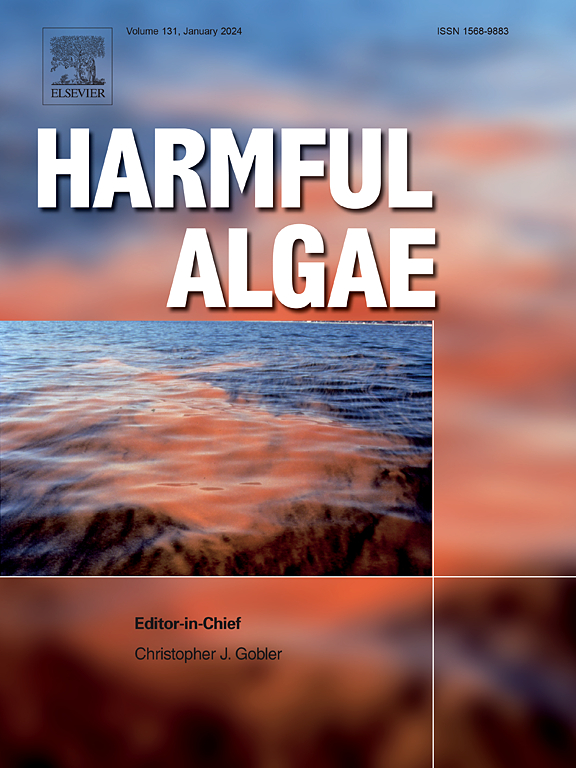美国纽约州河口由甲藻(Dinophysis acuminata)引起的有害藻华期间北大西洋双壳类动物的清除率和毒素积累。
IF 5.5
1区 生物学
Q1 MARINE & FRESHWATER BIOLOGY
引用次数: 0
摘要
腹泻性贝类中毒(DSP)是由于食用了双壳类动物而引起的中毒综合征,这些双壳类动物积累了由尖藻(Dinophysis acuminata)等藻类产生的毒素,但没有研究调查过双壳类动物以这种毒素为食的速度。在2021年和2022年期间,在美国纽约(NY)的三个地点暴露于不同密度(102 - 105个细胞L-1)的D. acuminata花中,量化了北大西洋西部三种具有商业意义的双壳类(Crassostrea virginica,雇佣兵(雇佣兵)和Mytilus edulis)的清除率(CR)。同样的双壳类动物被部署在纽约经历双藻华的地点,以跟踪腹泻贝类毒素(DSTs)和pectenotoxins (PTXs)的积累和清除率,这两种毒素分别对人类或贝类有害。本地非商业贻贝物种(Geukensis desmissa)也被就地取样以量化毒素积累。所有双壳类动物对尖锐裂裂螨的清除率均大于叶绿素-a-基率,且金针菇对尖锐裂裂螨的清除率(1.69±1.34 L h-1 g-1)显著高于毛毛螨(0.46±0.32 L h-1 g-1)和金针菇(0.41±0.24 L h-1 g-1);P < 0.05)。在2021年的一次水华事件中,锦绣江绣花和金银花积累了低水平的果胶毒素-2 (PTX2),而在2022年更持续的水华事件中,锦绣江绣花、毛毛江绣花和锦绣江绣花积累了DSTs(山田酸(OA)、甲藻毒素-1 (DTX1))、PTX2和果胶毒素-2二酸(PTX2sa)的组合,毛绣江绣花的DST量(265 ng OA + DTX1 g-1贝类组织)超过了FDA的关闭指南(160 ng毒素g-1),持续了三周。毛竹中DST含量显著高于锦绣蒿和金银花(p < 0.05),锦绣蒿中PTX2含量显著高于其他双壳类(p < 0.05)。毛蕊花和锦绣花的PTX2sa含量基本相同,且显著高于PTX2含量(p < 0.05)。毛毛霉的毒素积累效率(TAEs)高于锦绣菊,DSTs的TAEs高于PTX2和PTX2sa。在所有双壳类动物中,即使在bbb105细胞L-1中,也观察到尖锐裂裂裂齿藻的快速CR,以及毛利裂裂裂齿藻等双壳类动物快速积累高水平DSTs的能力,表明这些有害藻华可能是北美地区DSP的重大威胁。本文章由计算机程序翻译,如有差异,请以英文原文为准。
Clearance rates and toxin accumulation by North Atlantic bivalves during harmful algal blooms caused by the dinoflagellate, Dinophysis acuminata, in NY, USA, estuaries
Diarrhetic shellfish poisoning (DSP) is the intoxication syndrome derived from the consumption of bivalves that have accumulated toxins produced by algae such as Dinophysis acuminata, yet no study has examined the rate at which bivalves feed on this toxigenic species. During 2021 and 2022, the clearance rates (CR) of three commercially significant bivalve species native to the western North Atlantic (Crassostrea virginica, Mercenaria mercenaria, and Mytilus edulis) were quantified during exposure to D. acuminata blooms of varying densities (102 – 105 cells L−1) at three sites across New York (NY), USA. The same bivalve species were deployed at NY sites experiencing Dinophysis blooms to track accumulation and depuration rates of diarrhetic shellfish toxins (DSTs) and pectenotoxins (PTXs), toxins that are harmful to humans or shellfish, respectively. A native, non-commercial mussel species (Geukensis demissa) was also sampled in situ to quantify toxin accumulation. CR of D. acuminata were greater than chlorophyll-a-based-rates for all bivalves and clearance rates of D. acuminata by C. virginica (1.69 ± 1.34 L h−1 g−1) were significantly greater than those of M. edulis (0.46 ± 0.32 L h−1 g−1) and M. mercenaria (0.41 ± 0.24 L h−1 g−1; p < 0.05). During a bloom event in 2021, C. virginica and M. mercenaria accumulated low levels of pectenotoxin-2 (PTX2), whereas during a more sustained bloom in 2022, C. virginica, M. edulis, and G. demissa accumulated combinations of DSTs (okadaic acid (OA), dinophysistoxin-1 (DTX1)), PTX2, and pectenotoxin-2 seco acid (PTX2sa) with M. edulis DST loads (265 ng OA + DTX1 g−1 shellfish tissue) exceeding the FDA closure guideline (160 ng toxin g−1) for three weeks. DST concentrations in M. edulis were significantly higher (p < 0.05) than C. virginica and M. mercenaria, whereas PTX2 concentrations in C. virginica were significantly higher than in all other bivalves (p < 0.05). PTX2sa loads in M. edulis and C. virginica were similar to each other and were significantly greater than PTX2 loads (p < 0.05). Toxin accumulation efficiencies (TAEs) were higher for M. edulis than C. virginica, and TAEs for DSTs were higher than for PTX2 and PTX2sa in both species. The combination of rapid CR of D. acuminata observed in all bivalves, even at >105 cells L−1, and the ability of bivalves such as M. edulis to rapidly accumulate high levels of DSTs demonstrate these HABs may represent a significant DSP threat in North America.
求助全文
通过发布文献求助,成功后即可免费获取论文全文。
去求助
来源期刊

Harmful Algae
生物-海洋与淡水生物学
CiteScore
12.50
自引率
15.20%
发文量
122
审稿时长
7.5 months
期刊介绍:
This journal provides a forum to promote knowledge of harmful microalgae and macroalgae, including cyanobacteria, as well as monitoring, management and control of these organisms.
 求助内容:
求助内容: 应助结果提醒方式:
应助结果提醒方式:


